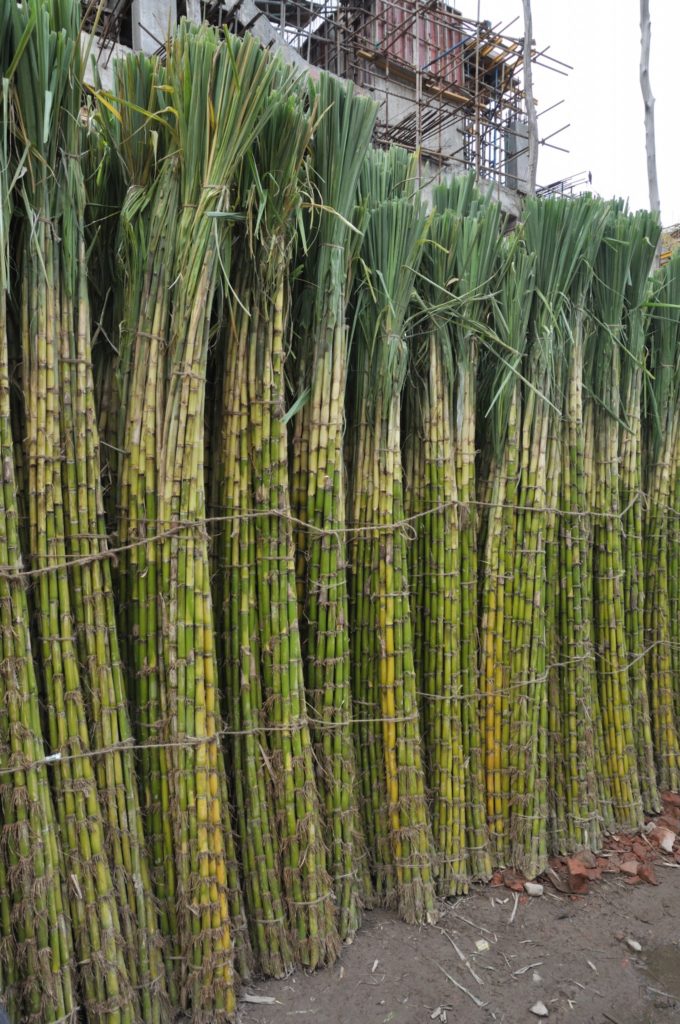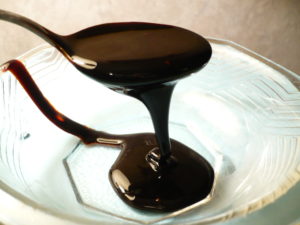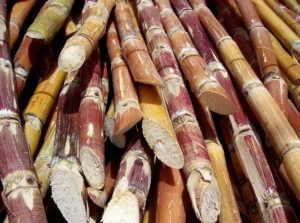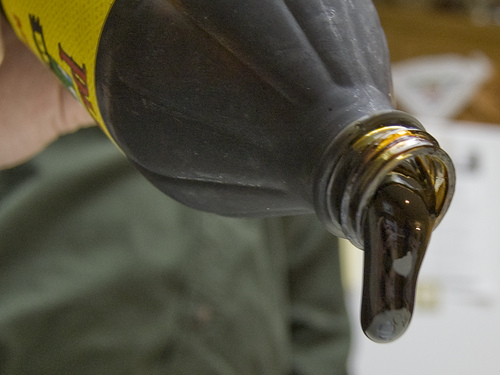I have addressed the topic of natural sugars and sweeteners in many posts (like Is Sugar Paleo? and Sugar Vs. Sweeteners and Why Is Sugar Bad?) and was also interviewed for a New York Post article on natural sweeteners just last week. My stance can be summarized as follows: some sugar in moderation and occasionally is just fine, nutrient-density is the most important quality of a healthy diet, not all natural sweeteners are okay even for occasional consumption, and it’s important to figure out what works best for you.
Table of Contents[Hide][Show]
But, I want to talk about one sugar that gets lumped in with the others that maybe should just be considered a good food, rather than a special treat: yes, unsulfured blackstrap molasses.
I believe the metric for determining whether or not a food is a healthful food is not whether or not caveman had access to something similar, but rather: what does that food have nutrientwise to offer the human body versus what does that food contain that might undermine health? And when we apply this metric to blackstrap molasses, we find that it makes very little sense to put this on a “no” list.
So, let’s discuss what molasses has to offer!
What Exactly Is Molasses?
Have you ever caught a whiff of gingerbread as it cooks, filling the kitchen with an amazing aroma? Or enjoyed a bowl of traditional baked beans or brown-sugar-glazed bacon? We can thank molasses for those rich scents and flavors!
 Molasses is a brown, viscous byproduct of sugar making, typically produced from sugarcane or sugar beets (although grapes, sorghum, dates, pomegranate, carob, and a number of other foods can also produce molasses-like products). After sugarcane is harvested and its juice is extracted (typically by cutting, crushing, or mashing), the juice undergoes multiple boilings to concentrate it and allow sugar crystals to form. The dark, thick syrup remaining after the sugar crystals are removed is what we call molasses.
Molasses is a brown, viscous byproduct of sugar making, typically produced from sugarcane or sugar beets (although grapes, sorghum, dates, pomegranate, carob, and a number of other foods can also produce molasses-like products). After sugarcane is harvested and its juice is extracted (typically by cutting, crushing, or mashing), the juice undergoes multiple boilings to concentrate it and allow sugar crystals to form. The dark, thick syrup remaining after the sugar crystals are removed is what we call molasses.
Many of us have been led to believe that because molasses is associated with sugar, it must be a processed sweetener that’s best avoided (or at least, used very sparingly). This couldn’t be further from the truth! Molasses is surprisingly nutrient dense, and could even be considered a superfood based on its impressive vitamin and mineral content. Not to mention, its strong, robust flavor is an irreplaceable component of a number of recipes.
But, as with most foods, not all molasses is created equal! Three different types of molasses are available, distinguished by the number of times the cane or beet juice has been boiled. And each type differs not only in appearance and flavor, but also in nutritional composition, since each subsequent boiling removes more sugar and further concentrates the remaining nutrients. It’s important to know which molasses to look for to get the maximum nutritional benefit!
Types of Molasses
Light molasses (also called Barbados molasses) is the result of the first round of boiling and sugar crystal extraction, and is sweetest and lightest in color. But, it doesn’t offer much in the way of micronutrients (it only has about 25% of the nutritional content of blackstrap (third boiling) molasses), and its sugar content is highest among all of the molasses types (since less sugar has been crystalized and removed).
 Dark molasses (also called robust molasses) is the result of the second boiling and sugar crystal extraction. It’s less sweet and slightly bitter compared to light molasses, with a relatively higher nutritional content. This is the type of molasses that is found in most grocery stores and is typically used for making gingerbread and other sweet baked goods.
Dark molasses (also called robust molasses) is the result of the second boiling and sugar crystal extraction. It’s less sweet and slightly bitter compared to light molasses, with a relatively higher nutritional content. This is the type of molasses that is found in most grocery stores and is typically used for making gingerbread and other sweet baked goods.
Blackstrap molasses is the residue remaining after the third and final boiling, and as a result, it’s thicker, darker, and more nutritious than any other molasses! It also has a much stronger flavor and lower sugar content, since three rounds of sugar crystals have been removed (most of the remaining sugar is caramelized, contributing to the dark brown color of the syrup). Basically, as refined sugar is extracted, all of the nutrients originally present are concentrated in this final product, blackstrap molasses! You can usually find this type of molasses in specialty grocery stores and health food stores.
Speaking of nutrition facts, let’s take a look at just what blackstrap molasses has to offer. One tablespoon (20 grams) contains only 47 calories, but packs in:
Nutrivore Weekly Serving Matrix
An easy-to-use and flexible weekly checklist
to help you maximize nutrient-density.
The Weekly Serving Matrix is very helpful! I’ve been eating along these lines but this really helps me know where to focus vs. which foods serve a more secondary role. It’s super helpful and has taken a lot of worry out of my meal planning. Thanks!
Jan
- Iron (3.6 mg, or 20% of the RDA)
- Calcium (176 mg, or 17.6% of the RDA)
- Copper (0.42 mg, or 21% of the RDA)
- Manganese (0.54 mg, or 27% of the RDA)
- Magnesium (44 mg, or 11% of the RDA)
- Potassium (510 mg, or 9.7% of the RDA)
- B vitamins, including B6 (0.15 mg, or 7.5% of the RDA) and smaller amounts of B2 and B3
- Selenium (3.6 mg, or 5.2% of the RDA)
- Small amounts of sodium, zinc, and phosphorus
How’s that for an impressive nutrient lineup? Blackstrap molasses has over five times as much iron as steak and 1.5 times as much calcium as cheese (per calorie). There aren’t many foods that can boast those kinds of micronutrient levels!
In fact, this qualifies blackstrap molasses as a nutrient-dense food. Yes, it does contain sugar (roughly 50% sucrose, 25% glucose and 25 fructose), but the amount of nutrition per calorie is still very impressive. Like all foods containing carbohydrates, especially simple ones, overdoing the amount we eat at a given time can cause high blood sugar levels which can eventually lead to loss of insulin sensitivity and predispose us to diabetes. The glycemic index of blackstrap molasses is reported to be 55 (right on the border between low and moderate) compared to table sugar which is 80 (high). That puts this caution in the same category of fruit and moderate glycemic load starchy veggies–it’s a great choice, but just make sure your blood sugar levels stay regulated (read: don’t drink the whole bottle).
A History as a Healing Food
 Historically, blackstrap molasses has been used not only as a cooking ingredient, but also medicinally. It was traditionally given as a remedy for an upset stomach, used directly in the ear to treat earaches (although I don’t recommend you try that!), and papers dating back to the 1930s and earlier discuss it as therapy for iron-deficiency anemia due to its high iron content and ability to raise serum ferritin. Even today, it’s proposed as a treatment for anemia associated with inflammatory bowel disease and menorrhagia, and can be an excellent supplement for vegetarians and anyone else who doesn’t eat much iron-rich red meat or organ meats.
Historically, blackstrap molasses has been used not only as a cooking ingredient, but also medicinally. It was traditionally given as a remedy for an upset stomach, used directly in the ear to treat earaches (although I don’t recommend you try that!), and papers dating back to the 1930s and earlier discuss it as therapy for iron-deficiency anemia due to its high iron content and ability to raise serum ferritin. Even today, it’s proposed as a treatment for anemia associated with inflammatory bowel disease and menorrhagia, and can be an excellent supplement for vegetarians and anyone else who doesn’t eat much iron-rich red meat or organ meats.
Thanks to its specific array of nutrients (at significant levels for human health), molasses helps support a number of body processes. It’s a great food for enhancing oxygen transport and energy production (which involve iron); supporting healthy skeletal tissue, muscle and blood vessel contraction, and nervous system function (which involve calcium); producing red blood cells, forming collagen, and keeping nerve cells healthy (which involve copper); manufacturing sex hormones, supporting carbohydrate and fat metabolism, and forming clotting factors (which involve manganese); synthesizing protein, regulating blood glucose, and controlling blood pressure (which involve magnesium); aiding in nerve conduction and maintaining a normal water balance between cells and body fluids (which involve potassium); supporting cellular metabolism (which involves the B vitamins); and assisting with thyroid function, DNA production, and antioxidant defenses (which involve selenium). Whew, talk about a wonder food!
Choosing the Right Molasses
 Along with making sure the molasses is blackstrap instead of light or dark (to maximize micronutrient content), there’s another detail to watch out for. Look for unsulfured blackstrap molasses (typically spelled the British way, unsulphured, on molasses bottles), which means the molasses has been processed without sulfur dioxide (a bleaching and antimicrobial agent). Sulfur is sometimes used in molasses to extend its shelf life and kill bacteria and mold, and assist in processing sugarcane that’s been harvested at an early stage (opposed to fully sun-ripened sugarcane). But, it can also be allergenic (especially to people sensitive to sulfites) and alters the taste of the molasses, giving it a chemical flavor. Unsulfured molasses made from mature (rather than green) sugarcane is considered higher quality and better tasting.
Along with making sure the molasses is blackstrap instead of light or dark (to maximize micronutrient content), there’s another detail to watch out for. Look for unsulfured blackstrap molasses (typically spelled the British way, unsulphured, on molasses bottles), which means the molasses has been processed without sulfur dioxide (a bleaching and antimicrobial agent). Sulfur is sometimes used in molasses to extend its shelf life and kill bacteria and mold, and assist in processing sugarcane that’s been harvested at an early stage (opposed to fully sun-ripened sugarcane). But, it can also be allergenic (especially to people sensitive to sulfites) and alters the taste of the molasses, giving it a chemical flavor. Unsulfured molasses made from mature (rather than green) sugarcane is considered higher quality and better tasting.
So, let’s not be afraid of adding this nutrient-dense food to our diets! Molasses, particularly unsulfured blackstrap, is a micronutrient powerhouse that can provide high levels of key nutrients at a low calorie cost.
Some of my recipes that feature blackstrap molasses:
- AIP Barbecue Sauce
- Gingerbread Cut-Outs
- Decadent Double Chocolate Cookies
- (Hidden Liver) Paleo Meatloaf
- Mexican Chocolate Coffee Cake
- Paleo Snickerdoodles
Citations
Aslan Y, et al. “Absorption of iron from grape-molasses and ferrous sulfate: a comparative study in normal subjects and subjects with iron deficiency anemia.” Turk J Pediatr. 1997 Oct-Dec;39(4):465-71.
“Blackstrap Molasses. In-Depth Nutritional Analysis.” World’s Healthiest Foods. Accessed November 5, 2015.
Crellin JK & Philpott J. “A Reference Guide to Medicinal Plants.” Duke University Press, 1990.
Ensminger ME & Ensminger AH. “Foods and Nutrition Encyclopedia, 2nd Edition.” CRC Press, 1993: page 83.
Harris RS, et al. “The nutritional availability of iron in molasses.” The American Journal of Digestive Diseases. 1939;6(7): 459-462.
Harris RS, et al. “Nutritional availability of iron in molasses.” International Sugar Journal. 1943;45:215-216.
Livdans-Forret AB, et al. “Menorrhagia: A synopsis of management focusing on herbal and nutritional supplements, and chiropractic.” J Can Chiropr Assoc. 2007 Dec; 51(4): 235–246.
Tunuguntla A & Sullivan MJ. “Black strap molasses for the treatment of inflammatory bowel disease-associated anemia.” South Med J. 2004 Aug;97(8):794.











